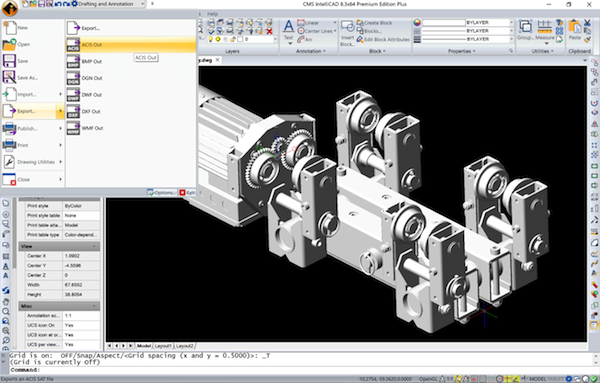
CMS IntelliCAD is one of many CAD products built using Open Design Alliance technology. Image courtesy of CMS.
Latest News
October 1, 2020
In an unusual turn of events, big news about the Open Design Alliance was not announced at ODA’s recent developers conference but afterwards — by its newest member and former antagonist Autodesk.
It is understandable if you needed to reread the previous sentence to believe what you read. Since its creation more than 20 years ago, the ODA has served its members by creating and supporting a reverse-engineered version of the DWG file format popularized by Autodesk AutoCAD. There has been more than one lawsuit between the two over the years. Former Autodesk CEO Carl Bass once referred to the ODA as “the arms merchant for my enemies.”
So why the change of heart? Autodesk is under considerable pressure from its Revit user base in AEC to improve interoperability for BIM (Building Information Modeling). When AutoCAD was the leading tool for architecture and construction, the ODA’s version of DWG filled the interoperability gap (as it continues to do for product design and manufacturing today). For the sake of accuracy, AEC firms have turned to direct sharing of Revit files, even at the cost of shutting out users who prefer other software products. (As with mechanical engineering, there are several companies making AEC CAD software.) Revit’s file formats are proprietary, and have started to become a de facto common file format for construction the way DWG did a generation ago.
Revit can also import/export to a vendor-neutral data format, Industry Foundation Classes (IFC). Users have always complained that Autodesk’s support of IFC for Revit was tepid. Updates came late, and conversions almost always need further editing.
In 2018 ODA started shipping a Software Development Kit (SDK) for Revit compatibility. Last year ODA announced a partnership with the non-profit behind IFC, buildingSmart International, and is now shipping the first iteration of its new IFC support. It seems Autodesk has decided it would be better to join the IFC interoperability effort than continue to swim upstream against the wishes of its users.
The agreement between Autodesk is very specific; it covers only IFC. Standard ODA membership terms require member companies to share any code they develop for DWG compatibility with ODA for the benefit of all members. Autodesk was granted an exception. If the old phrase “burying the hatchet” is a metaphor for this new agreement, the hatchet is only half buried.
Autodesk and the ODA are not commenting beyond the initial announcement, which was published in an Autodesk blog as a statement from Autodesk VP Amy Bunszel. “This decision demonstrates our commitment to take meaningful steps towards improving our customers’ experience in the AEC space,” Bunszel wrote.
The comments of Dr. Stefan Boeykens, a guest professor of BIM at KU Leuven (Belgium) and a practicing architect, are typical of what users are saying on social media about the announcement. “So alongside the internal C++ and C# code bases (which both still exist in Revit) [Autodesk] will now add a third attempt to properly support IFC. Maybe this time they can show their competitors that Revit can play nicely in IFC exchange after all. The underwhelming IFC support by Revit is costing the industry a lot, although it does bring business to countless BIM consultants trying to get things to work more or less in projects. But I prefer better IFC support over the whole industry being forced to adopt the RVT format,” he said.
[Note: You can read more about the announcement here.]

Meanwhile in DWG
Although the Autodesk announcement overshadowed any news from the conference, ODA had plenty to say about the value of its work to make DWG more than a file format. “For us, DWG is a powerful framework for application development,” said Neil Peterson, ODA president. With hundreds of products in all CAD disciplines based on ODA technology, the Alliance has become a primary development partner for a wide variety of software companies. Using ODA technology allows software makers to add version control and support for cloud technologies, for example. By comparison, Autodesk does not offer version control in AutoCAD. An independently produced white paper comparing AutoCAD Web against a product made using ODA technology (Graebert Ares Kudo) concludes the ODA-based product “significantly outperforms AutoCAD Web in almost every category.”
Open Cloud SDK, ODA’s stack for cloud, is not a turnkey Software as a Service (SaaS) product, Peterson says. “We give you tools to host your own applications and control your own IP.” The customizable platform works with both Microsoft Azure and Amazon Web Services. The most recent release includes new options for working with a range of MCAD formats including data from SolidWorks, CATIA, and products using the JT open data format from Siemens.
Specific recent improvements to ODA SDKs of interest to mechanical CAD include:
- Improvements to PDF Import into a DWG database: Import full lines of PDF text as MTEXT; Import linetypes; Support for clipping regions during import.
- Boolean operations (union, intersection, etc.) in the DWG database are now supported by the ODA Solid Modeler.
- ODA’s native revision control for DWG has been refactored to allow easier integration into real-world client applications. The new implementation allows clients to more easily implement revision history for groups of related files, including non-DWG files.
- PDF export has been enhanced to use graphics caching to improve performance in cases where multiple views of a model are exported to the same PDF file.
- New DGN export from a DWG database. ODA now supports both DGN-to-DWG conversion and DWG-to-DGN conversion.
- Automatic level of detail selection for RCS point cloud visualization supports fast visualization and manipulation of large RCS point clouds.
- Conversion of point cloud data to RCS format.
- Improvements to model documentation view support: New VIEWSECTION, VIEWBASE, and VIEWPROJ commands for convenient creation of model doc views; Saving model document views to standard DWG files (in progress); Precision hidden line removal support (in progress).
“The ODA technology stack is our value proposition,” says Peterson, “and our stack is ready for prime time.” ODA is also working on extending its solid modeler SDK to be a multi-user application, taking advantage of its previous work in version control and cloud CAD. No specific availability date was provided.
More Autodesk Coverage
Subscribe to our FREE magazine, FREE email newsletters or both!
Latest News
About the Author
Randall S. Newton is principal analyst at Consilia Vektor, covering engineering technology. He has been part of the computer graphics industry in a variety of roles since 1985.
Follow DERelated Topics







